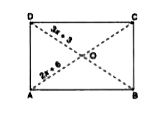In rhombus ABCD, diagonals AC and BD intersect each other at point O.
If cosine of angle CAB is 0.6 and OB = 8 cm, find the lengths of the side and the diagonals of the rhombus.
The correct Answer is:[OB = 8 cm] side = 10 cm , diagonal AC = 12 cm and diagonal BD = 16 cm
To solve the problem, we will follow these steps:
Step 1: Understand the properties of the rhombus
In a rhombus, the diagonals bisect each other at right angles. Therefore, if diagonals AC and BD intersect at point O, we have:
- AO = OC
- BO = OD
- ∠AOB = ∠COD = 90°
Step 2: Use the given information
We are given:
- cos(∠CAB)=0.6
- OB=8cm
Step 3: Identify the triangle to use
We will consider triangle OAB. In this triangle:
- OB is the adjacent side to angle CAB.
- OA is the opposite side to angle CAB.
- AB is the hypotenuse.
Step 4: Use the cosine definition
From the definition of cosine:
cos(θ)=AdjacentHypotenuse=OBAB
Given cos(θ)=0.6, we can express it as:
0.6=OBAB
Substituting OB=8cm:
0.6=8AB
Step 5: Solve for AB
Cross-multiplying gives:
0.6⋅AB=8
AB=80.6=806=403≈13.33cm
Step 6: Find the lengths of the sides of the rhombus
Since all sides of a rhombus are equal, the length of each side AB=10cm.
Step 7: Use sine to find OA
We know that:
sin(θ)=OppositeHypotenuse=OAAB
Using the Pythagorean identity, if cos(θ)=0.6, then:
sin2(θ)+cos2(θ)=1
sin2(θ)+(0.6)2=1
sin2(θ)+0.36=1
sin2(θ)=0.64⟹sin(θ)=0.8
Step 8: Solve for OA
Now substituting into the sine definition:
0.8=OAAB
Substituting AB=10cm:
0.8=OA10
OA=0.8⋅10=8cm
Step 9: Find the lengths of the diagonals
The lengths of the diagonals are:
- AC=2⋅OA=2⋅6=12cm
- BD=2⋅OB=2⋅8=16cm
Final Results
- Length of each side of the rhombus: 10cm
- Length of diagonal AC: 12cm
- Length of diagonal BD: 16cm
In a rhombus, the diagonals bisect each other at right angles. Therefore, if diagonals AC and BD intersect at point O, we have:
- AO = OC
- BO = OD
- ∠AOB = ∠COD = 90°
We are given:
- cos(∠CAB)=0.6
- OB=8cm
We will consider triangle OAB. In this triangle:
- OB is the adjacent side to angle CAB.
- OA is the opposite side to angle CAB.
- AB is the hypotenuse.
From the definition of cosine:
cos(θ)=AdjacentHypotenuse=OBAB
Given cos(θ)=0.6, we can express it as:
0.6=OBAB
Substituting OB=8cm:
0.6=8AB
Cross-multiplying gives:
0.6⋅AB=8
AB=80.6=806=403≈13.33cm
Since all sides of a rhombus are equal, the length of each side AB=10cm.
We know that:
sin(θ)=OppositeHypotenuse=OAAB
Using the Pythagorean identity, if cos(θ)=0.6, then:
sin2(θ)+cos2(θ)=1
sin2(θ)+(0.6)2=1
sin2(θ)+0.36=1
sin2(θ)=0.64⟹sin(θ)=0.8
Now substituting into the sine definition:
0.8=OAAB
Substituting AB=10cm:
0.8=OA10
OA=0.8⋅10=8cm
The lengths of the diagonals are:
- AC=2⋅OA=2⋅6=12cm
- BD=2⋅OB=2⋅8=16cm
- Length of each side of the rhombus: 10cm
- Length of diagonal AC: 12cm
- Length of diagonal BD: 16cm
Topper's Solved these Questions
- BOOK - ICSECHAPTER - TRIGONOMETRICAL RATIOS EXERCISE - EXERCISE 22(A)47videos
TRIGONOMETRICAL RATIOS
- BOOK - ICSECHAPTER - TRIANGLES EXERCISE - 4 MARKS QUESTIONS24videos
TRIANGLES
- BOOK - ICSECHAPTER - TRIGONOMETRICAL RATIOS OF STANDARD ANGLESEXERCISE - EXERCISE 23(C)118videos
TRIGONOMETRICAL RATIOS OF STANDARD ANGLES
Similar Questions
Diagonals AC and BD of a parallelogram ABCD intersect each other at O. If OA= 3 cm and OD = 2 cm, determine the lengths of AC and BD.
View SolutionIn a rhombus ABCD the diagonals AC and BD intersect at the point (3,4) . If the point A is (1,2) the diagonal BD has the equation
View SolutionIn quadrilateral ABCD, the diagonals AC and BD intersect each other at point O.
If AO = 2CO and BO = 2DO, show that:
ΔAOB is similar to ΔCOD.View SolutionIn quadrilateral ABCD, the diagonals AC and BD intersect each other at point O.
If AO = 2CO and BO = 2DO, show that:
OA×OD=OB×OC.View Solution
In the given figure, the diagonals AC and BD of a rectangle ABCD intersect each other at point O.
If OA=2x+6 and OD=3x+3, find the value of x.View SolutionTwo opposite angles of a rhombus are 60° each. If the length of each side of the rhombus is 8 cm, find the lengths of the diagonals of the rhombus.
View SolutionEach side of a rhombus is 10cm. If one of its diagonals is 16cm find the length of the other diagonal.
View SolutionIf the diagonals of a rhombus are 12cm and 16cm, find the length of each side.
View SolutionIf the diagonals of a rhombus are 12cm and 16cm, find the length of each side.
View SolutionThe side of a rhombus is 13 cm. if one if the diagonals is 24 cm, find the length of the other diagonal.
View Solution

